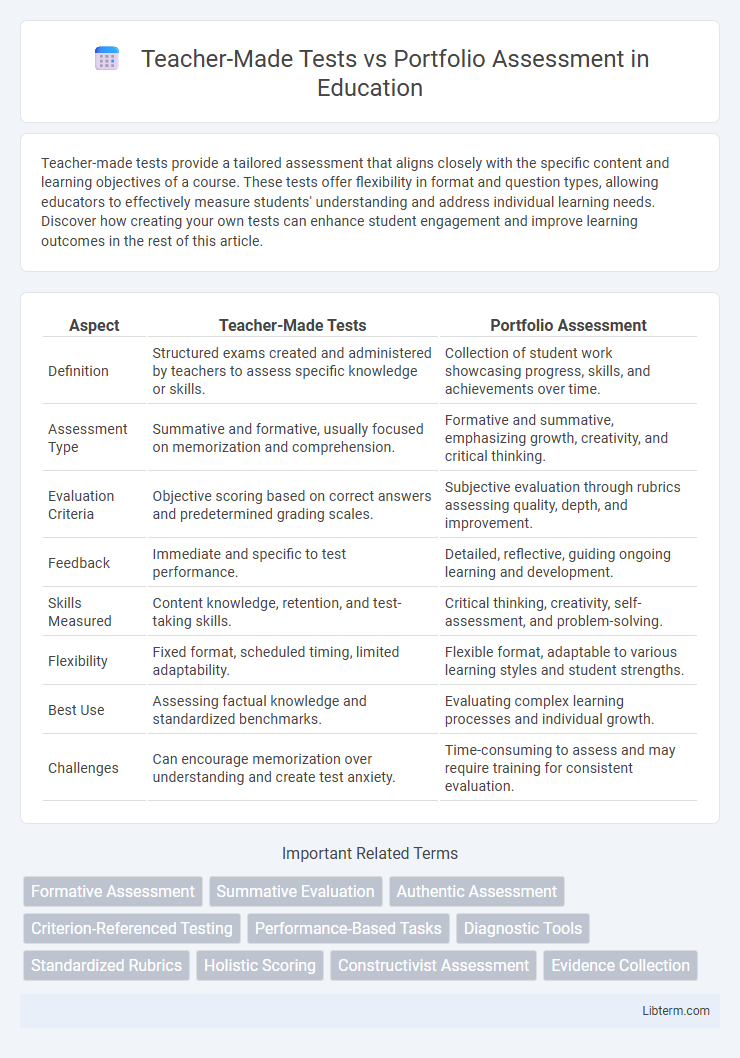Teacher-made tests provide a tailored assessment that aligns closely with the specific content and learning objectives of a course. These tests offer flexibility in format and question types, allowing educators to effectively measure students' understanding and address individual learning needs. Discover how creating your own tests can enhance student engagement and improve learning outcomes in the rest of this article.
Table of Comparison
| Aspect | Teacher-Made Tests | Portfolio Assessment |
|---|---|---|
| Definition | Structured exams created and administered by teachers to assess specific knowledge or skills. | Collection of student work showcasing progress, skills, and achievements over time. |
| Assessment Type | Summative and formative, usually focused on memorization and comprehension. | Formative and summative, emphasizing growth, creativity, and critical thinking. |
| Evaluation Criteria | Objective scoring based on correct answers and predetermined grading scales. | Subjective evaluation through rubrics assessing quality, depth, and improvement. |
| Feedback | Immediate and specific to test performance. | Detailed, reflective, guiding ongoing learning and development. |
| Skills Measured | Content knowledge, retention, and test-taking skills. | Critical thinking, creativity, self-assessment, and problem-solving. |
| Flexibility | Fixed format, scheduled timing, limited adaptability. | Flexible format, adaptable to various learning styles and student strengths. |
| Best Use | Assessing factual knowledge and standardized benchmarks. | Evaluating complex learning processes and individual growth. |
| Challenges | Can encourage memorization over understanding and create test anxiety. | Time-consuming to assess and may require training for consistent evaluation. |
Introduction to Teacher-Made Tests and Portfolio Assessment
Teacher-made tests are customized evaluations designed by educators to measure specific learning objectives and student understanding, allowing for targeted feedback and curriculum alignment. Portfolio assessment involves the systematic collection of student work over time, showcasing progress, skills, and achievements through diverse artifacts such as essays, projects, and reflections. Both approaches serve distinct educational purposes, with teacher-made tests emphasizing immediate content mastery and portfolio assessments highlighting long-term growth and comprehensive skill development.
Defining Teacher-Made Tests: Purposes and Methods
Teacher-made tests serve as tailored assessment tools designed by educators to measure students' understanding and mastery of specific course content, aligning closely with instructional objectives. These tests often include multiple-choice, short-answer, and essay questions strategically crafted to evaluate knowledge retention, critical thinking, and application skills. Methods for creating teacher-made tests involve outlining clear learning goals, selecting relevant content areas, and employing varied question formats to accurately gauge student performance and guide instructional decisions.
Portfolio Assessment: Key Concepts and Components
Portfolio assessment emphasizes the systematic collection and evaluation of a student's work over time, highlighting growth, creativity, and critical thinking. Key components include a diverse range of artifacts such as written assignments, projects, and reflective journals, along with clear criteria for assessment that align with learning objectives. This approach fosters self-assessment and personalized feedback, promoting a deeper understanding of student progress beyond traditional testing methods.
Advantages of Teacher-Made Tests in the Classroom
Teacher-made tests provide immediate and objective measurement of student knowledge, enabling teachers to quickly identify learning gaps and adjust instruction accordingly. They are customizable to align precisely with curriculum standards and specific learning objectives, ensuring targeted assessment. These tests also offer efficiency in grading and feedback, allowing for timely evaluation of student progress and mastery.
Strengths of Portfolio Assessment for Student Growth
Portfolio assessment provides a comprehensive view of student growth by showcasing diverse examples of work over time, reflecting deeper learning and skill development. It encourages self-reflection and critical thinking, empowering students to take ownership of their learning progress. This method supports personalized feedback and highlights individual strengths and areas for improvement beyond standardized testing metrics.
Limitations and Challenges of Teacher-Made Tests
Teacher-made tests often face limitations such as subjective grading, narrow focus on rote memorization, and potential bias, which can undermine the accuracy of student performance evaluation. These tests may also fail to assess higher-order thinking skills and real-world application, limiting their effectiveness in measuring comprehensive learning. Time constraints and teacher workload further challenge the development of high-quality, valid, and reliable tests.
Drawbacks and Hurdles in Portfolio Assessment
Portfolio assessment faces challenges such as time-intensive compilation and subjective evaluation standards, which can lead to inconsistent grading outcomes. Teachers may struggle with the lack of standardized criteria, making it difficult to ensure reliability and fairness across diverse student work. The complexity of managing extensive student artifacts also demands significant administrative effort, limiting its scalability in large classrooms.
Comparing Effectiveness: Which Method Suits Which Learner?
Teacher-made tests offer structured evaluation with quantifiable results, ideal for assessing knowledge retention and standardized content comprehension. Portfolio assessment provides a holistic view of a learner's progress by showcasing creativity, critical thinking, and skill application over time, benefiting students who excel in reflective and project-based tasks. Effectiveness depends on learner preferences and goals; teacher-made tests suit students needing clear benchmarks, while portfolios support personalized, in-depth evaluation for diverse learning styles.
Integrating Teacher-Made Tests and Portfolios for Balanced Assessment
Integrating teacher-made tests and portfolio assessments creates a balanced evaluation by combining objective measurement with qualitative insights into student learning. Teacher-made tests offer structured data on knowledge retention and skill proficiency, while portfolios provide comprehensive evidence of growth, creativity, and application over time. This dual approach enhances assessment validity and supports differentiated instruction tailored to diverse learner needs.
Conclusion: Choosing the Best Assessment Approach for Student Success
Selecting the optimal assessment approach depends on the specific learning objectives and student needs, as teacher-made tests provide measurable, objective data while portfolio assessments offer a comprehensive view of student growth and critical thinking skills. Combining both methods can create a balanced evaluation strategy that supports diverse learning styles and promotes deeper understanding. Prioritizing alignment with curriculum goals and timely feedback ensures the chosen assessment maximizes student success.
Teacher-Made Tests Infographic

 libterm.com
libterm.com